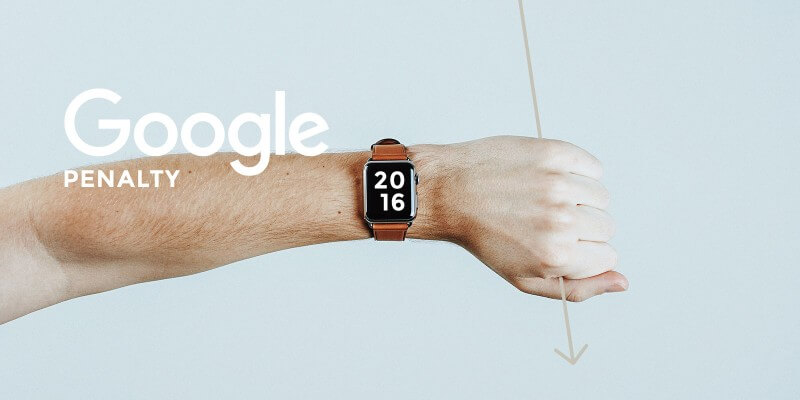Identifying & Recovering From Google Penalties in 2016
Jun 01, 2016
Has your precious website recently fallen out of favor with Google? Don’t worry, you’re not alone. According to Google themselves, 4.3 million websites are penalized annually.
Determining if you’ve been penalized is generally not that difficult. You’ll see a sudden massive drop in traffic if so.
Fortunately, Google penalties aren’t the end of the world. Whether it’s because you hired the wrong SEO company, or you didn’t understand how to market your website, follow our steps and you’ll be on the road to recovery in no time.
What Kind Of Penalty Do You Have?
Before you can take action, it’s important to understand what type of penalty you have, and how you got it. Two types of penalties exist: manual and algorithmic.
Manual Penaltiesmean that an actual person has reviewed your website and determined you violated Webmaster Guidelines in some form. This could happen if someone reports you or your site was flagged automatically. In these types of situations, you can find notice of a manual penalty within your Webmaster Tools under Search Traffic > Manual Actions.
Algorithmic Penalties are more difficult to detect. Google updates their search algorithm periodically and even a compliant website could find itself losing rank. The reason algorithmic penalties are difficult to diagnose is that there is no notice of action. You’ll need to make an educated guess in this situation. One way to do this is check when you saw a traffic drop, and compare it to update release dates. Moz has a handy tool for this. For example, the 2012 Google Penguin update penalized websites abusing backlink and anchor text strategies.
Another possibility is that the weight of certain metrics can be adjusted in updates, resulting in a reduction in ranking. Unfortunately, this is not a penalty. In order to avoid being crushed by a search update, don’t put all your eggs in one basket. Instead of relying only on highquality backlinks or certain keyword phrases you rank well on, build a diverse website that receives traffic through a variety of means.
Lastly, understand that it’s possible to be under both; a manual and algorithmic penalty, at the same time.
The Road To Recovery
Once you’ve determined the nature of your penalty, you can begin to take action.
1) Dump Bad Backlinks
Bad backlinks are … bad. Navigate back to your Webmaster Tools under Search Traffic > Links To Your Site. Take your time to go through each and every link, making note of spammy looking ones. For example, if you have a site about eating cake, and you see backlinks in the form of blog comments on a technology site, then this probably needs to go. Backlinks need to come from highquality sites with relevant content.
Once you’ve identified the bad links, try to contact the website owners requesting its removal. Be polite, it’s often not their fault. If you still have links that remain due to unresponsive site owners, then you’ll need to use the disavow tool.
The disavow tool allows you to submit a request to Google, which asks for them to ignore specific backlinks. It can take a few weeks to process, and the tool should only be used as a last resort.
The majority of penalties are due to backlinks. Clean up your backlink profile and you’ll be on the right track.
2) Be Careful With Anchor Text
Anchor text was once a powerful way to gain search ranking. Now it’s a quick way to gain a penalty. While there’s no magic formula, it’s a good idea to keep anchor text to the bare minimum. Large amounts of backlinks using the same phrase doesn’t look natural and alerts Google that you’re trying to circumvent their system. Make sure you have a diverse link profile that doesn’t repeat the same anchor text over and over.
3) Get Rid of Duplicate Content
If you have multiple pages of duplicate content on your site, then they need to be condensed and removed. Google doesn’t like messy sites. Clean it up.
In addition, never plagiarize or copy content from another site. Not only does stealing content violate Webmaster Guidelines, but Copyright laws as well.
4) Is Your Site Useful?
Gone are the days where you could make a quick buck ranking a thin site. Content is now king. If Google deems your site as spammy or one that has nothing to offer, you’ll find yourself quickly drowning with the rest of them.
Build a site that brings value to the table and “wows!” others. Create useful content with quality blog posts, involve yourself in social media, and add a touch of web design.
Ask yourself, “Does my product/service solve problems or bring value?”. If not, it’s time to go back to the drawing board.
Okay, My Site’s Clean. Now What?
Once you feel your site is cleaned up and in a good position, those with manual penalties can submit a reconsideration request. For algorithmic penalties, you can only wait. Unfortunately, it could take weeks or months.
If you’ve followed all the steps above, you should be able to gradually recover. In situations where recovery does not occur, there could be another underlying problem. It’s usually best to seek the advice of a reputable and professional SEO company to help you navigate through the penalty at this point.
Remember, Google is king and we’re playing in their court. Follow their rules, create useful content for searchers, and you’ll remain in their favor.
